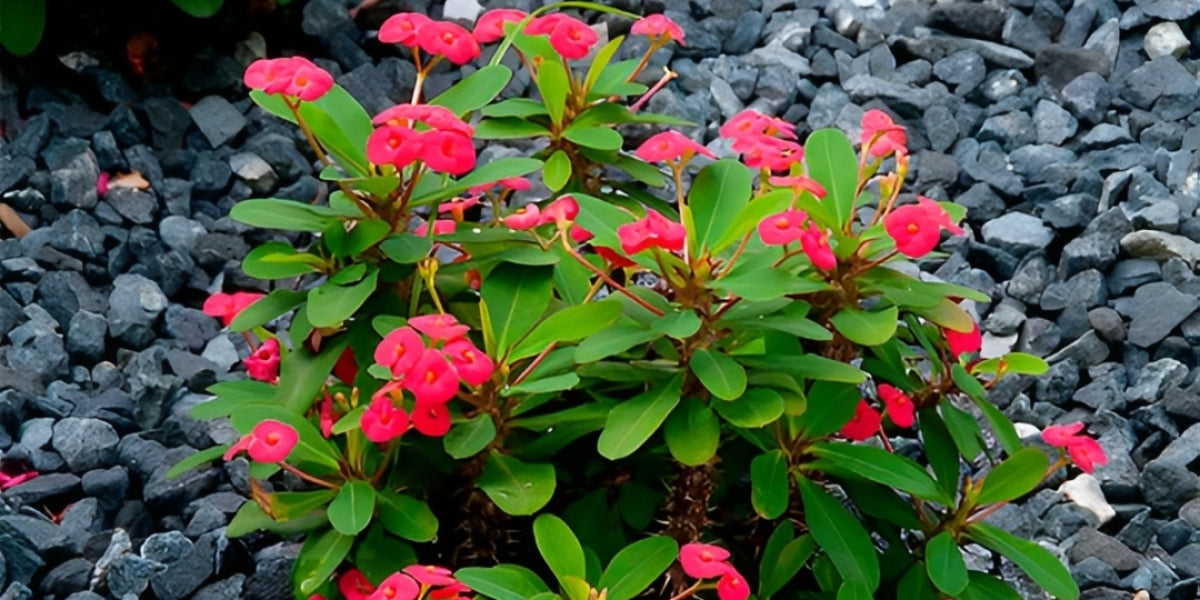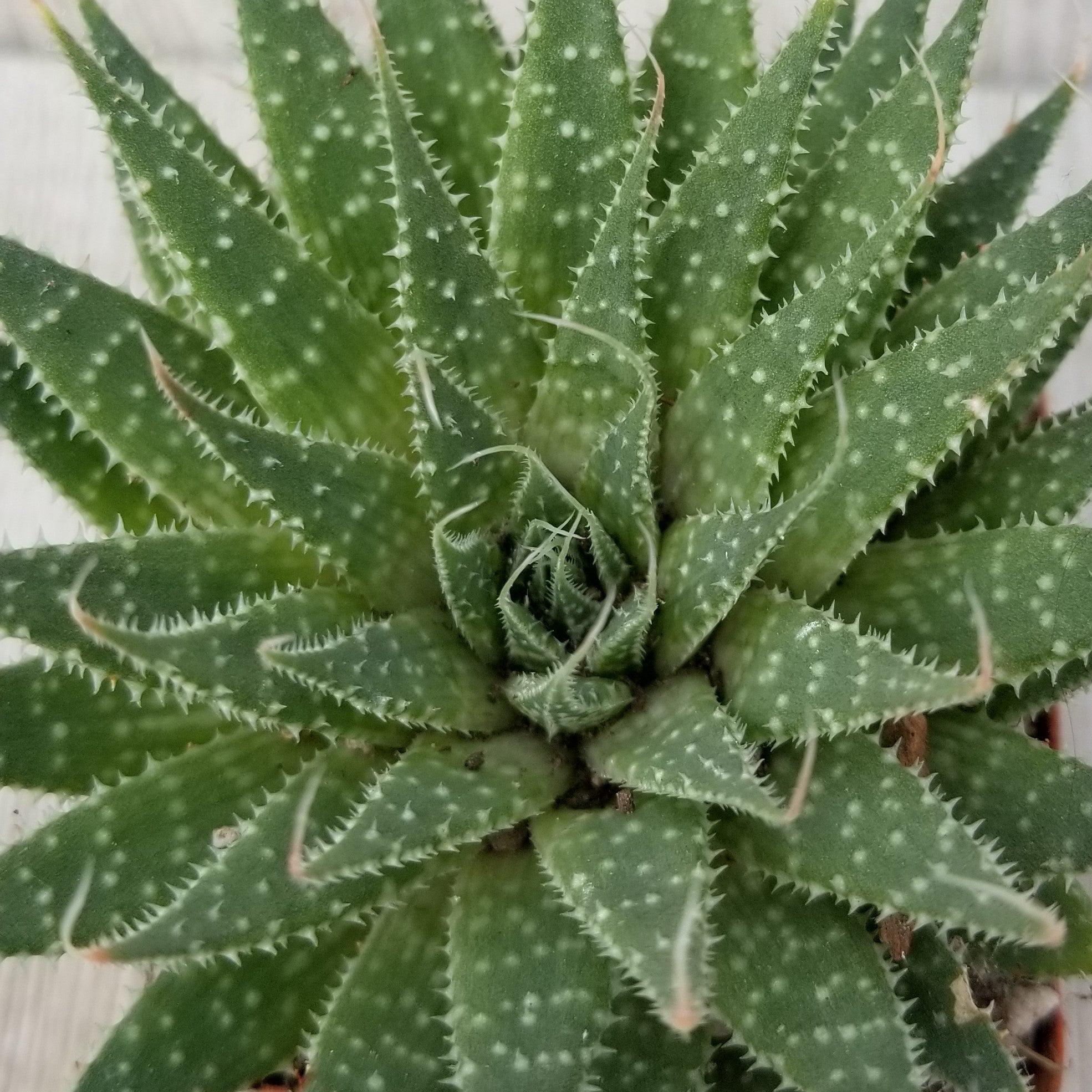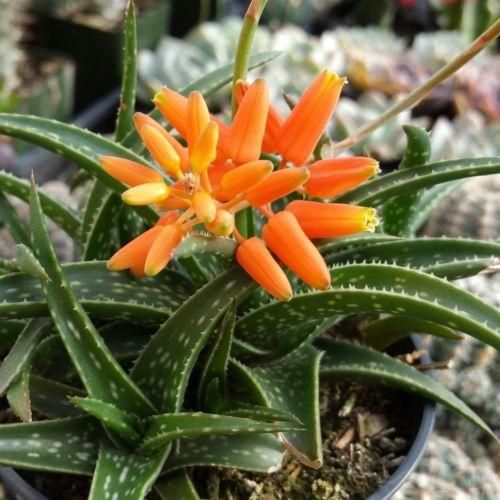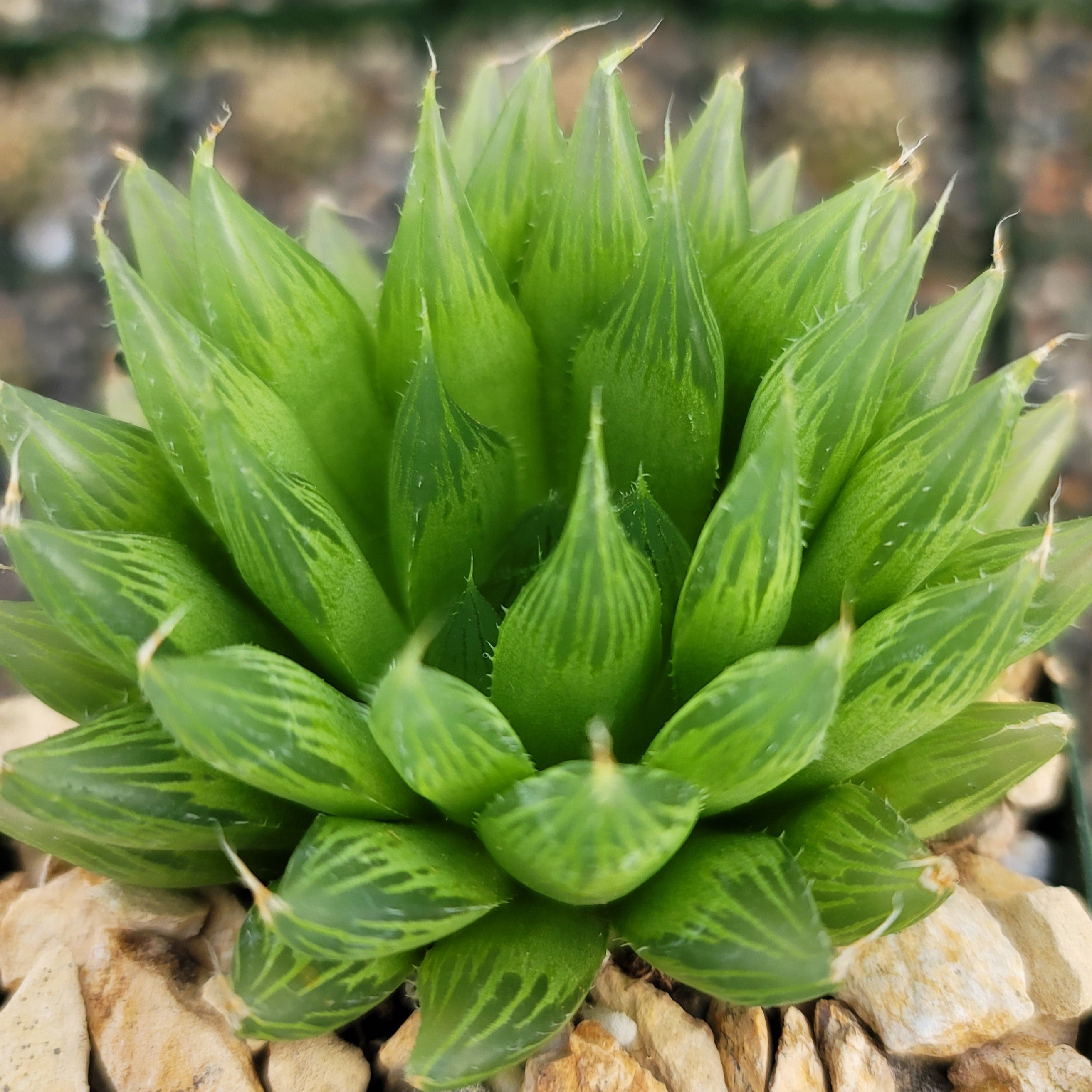Crown of Thorns Plant (Euphorbia milii) ‘Care & Growing Guide’ – Everything You Need to Know!
Updated: April 28, 2025

The Crown of Thorns plant, known as Euphorbia milii, is a hardy and popular houseplant known for its ability to bloom year-round in various colors, even indoors, and for its thick, vibrant green leaves. This slow-growing plant thrives in a variety of environments and is well-known for its adaptability and low maintenance requirements, making it a favorite among both indoor and outdoor gardening enthusiasts.
The Crown of Thorns is not just a succulent plant; it’s a symbol of endurance and protection, cherished for its historical and cultural significance. Historically, the Crown of Thorns plant holds significance in Christianity, where its stems are believed to have been used in the creation of Christ's crown of thorns. This association has made it a symbolic plant for many believers, particularly in regions where Christianity is widely practiced, such as the United States. It is celebrated as a symbol of good fortune in Thailand, and its eight-flowered clusters are thought to represent the eight saints of Chinese mythology, adding to its cultural appeal.
Crown of Thorns Plant – Why it is Popular

The Crown of Thorns plant is a remarkable and delightful succulent that is also referred to as the Christ Plant or Christ thorns, due to the legend that it was used as the thorny crown worn by Jesus at his crucifixion.
This thorn plant is celebrated for its resilience and ability to thrive in various conditions, making it a favorite among both indoor and outdoor gardeners. Whether indoors or outdoors, this versatile plant is a standout in any garden or home setting.
Native to Madagascar, the Euphorbia milii is a slow-growing plant and is known for its bright green leaves, vibrant flowers, and sharp thorns.
Over time, this succulent has been cultivated worldwide and has become a popular houseplant due to its ease of care and exotic appeal.
The Crown of Thorns is instantly recognizable by its thorn-covered stems, which serve as a natural defense mechanism and give the plant its name. Its lush, oval-shaped leaves are a vibrant green, providing a striking contrast to the small, colorful bracts that are often mistaken for flowers. These bracts, available in hues of red, pink, yellow, white, and creamy yellow bracts, surround the plant’s inconspicuous true flowers and add to its visual appeal.
One of the plant’s most admired features is its ability to bloom year-round under optimal conditions. With proper care, the Crown of Thorns can produce its cheerful bracts continuously, brightening up spaces even in less favorable seasons. Its compact growth habit and unique combination of thorns and delicate bracts make it a captivating centerpiece in any plant collection.
Crown of Thorns Flowers
The Crown of Thorns is cherished for its delicate, vibrant flowers that bloom almost year-round in the right conditions.
These "flowers" are actually colorful bracts that surround the plant's small, true flowers, creating a striking and unique display.
The bracts come in shades of red, pink, white, and yellow, adding a cheerful splash of color to homes or gardens.
One of the most appealing traits of the Euphorbia milii is its long-lasting blooming period.
Unlike many other flowering plants, it can produce blooms throughout the year, especially when provided with ample light.
The plant's spiky stems and thick, fleshy leaves complement the vibrant flowers, creating a dramatic yet balanced aesthetic.

Its drought tolerance and low-maintenance nature make it a favorite for busy gardeners and indoor plant enthusiasts.
To encourage prolific flowering, the Crown of Thorns requires specific care. Bright, direct sunlight is essential, as the plant thrives in well-lit areas, whether indoors near a sunny window or outdoors in a sunny location. Consistent watering is crucial, but the soil must be allowed to dry out completely between waterings to prevent root rot. Fertilizing every once a year during the growing season with a balanced, water-soluble NPK fertilizer can provide the nutrients necessary to promote more blooms.
Proper pruning can also enhance flowering by redirecting the plant’s energy toward new growth. Trimming leggy or dead branches will encourage a fuller, more robust plant that produces more flowers. Additionally, maintaining the plant in slightly snug pots encourages blooming, as the Crown of Thorns prefers to be slightly root-bound.
Crown of Thorns Plant Care
The Crown of Thorns plant is a remarkably low-maintenance succulent, making it a favorite among both novice and experienced gardeners. Its hardy nature allows it to thrive with minimal intervention, provided its basic needs are met. Its year-round blooming potential and ability to tolerate neglect make it a standout option for those seeking a long-lasting, easy-care addition to their home or garden.
Quick Reference

Bloom Season

Flower Color

Growth Rate

Hardiness Zone

Mature Size

Plant Type

Sun Exposure

Sun Exposure

Watering Needs
How to Water Euphorbia milii Plant for Optimal Growth
The Crown of Thorns is drought-tolerant and requires minimal watering, making it an ideal choice for low-maintenance plant enthusiasts. Its ability to store water in its thick, spiny stems allows it to thrive with infrequent watering, mimicking the arid conditions of its native habitat. Overwatering can be detrimental, leading to root rot or fungal issues, so it’s important to let the soil dry out between waterings. Adapting your watering routine to its growing and dormant seasons is essential for maintaining a thriving and resilient plant.
- As a general rule of thumb, don't water until the soil is dry and use the soak and dry method. In the spring and summer, during the active growing season, the Crown of Thorns requires regular watering to support its growth and vibrant blooms. Water the plant approximately once every 7–10 days, though the exact frequency will depend on environmental factors such as humidity, temperature, and sunlight exposure. Ensure that you water deeply enough to saturate the soil, allowing excess water to drain out completely. In regions with high heat or intense sun, you may need to adjust the schedule slightly to avoid stressing the plant.
- In the fall and winter, the Crown of Thorns enters a semi-dormant phase, during which it slows its growth and requires significantly less water. Water the plant sparingly, approximately once every 3–4 weeks, depending on the dryness of the soil and environmental conditions. The goal during this period is to prevent the soil from becoming completely bone dry while avoiding excessive moisture that can lead to root rot. Indoor plants, in particular, may require slightly more frequent watering if exposed to dry air from indoor heating systems. Always err on the side of caution, as this drought-tolerant plant prefers underwatering to overwatering during its dormant season.
By understanding and adjusting to the seasonal needs of your Crown of Thorns, you can ensure its health, promote blooming, and enjoy its striking appearance year-round.
Ideal Lighting for the Crown of Thorns Plant: Indoors & Outdoors
The Crown of Thorns thrives in bright, direct sunlight, which is essential for its growth, blooming, and overall health. This sun-loving plant flourishes when it receives adequate light, whether grown indoors or outdoors. Proper lighting not only promotes vibrant flowers but also prevents leggy, and weak growth. Below are detailed requirements for both indoor and outdoor settings.

- When grown indoors, the Crown of Thorns needs at least 6–8 hours of bright, indirect light daily to thrive. A sunny windowsill, preferably south- or west-facing, is ideal for providing consistent light. If natural sunlight is insufficient, consider using grow lights to supplement the plant's light exposure. Rotate the pot every few weeks to ensure even growth, as plants near windows may lean toward the light source.
- For outdoor cultivation, the Crown of Thorns prefers full sun exposure for at least 6 hours daily, though it can tolerate partial shade in extremely hot climates. Place the plant in a location that receives direct sunlight in the morning and dappled or partial shade during the hottest afternoon hours to prevent scorching. For potted outdoor plants, move them to a sunnier spot if you notice slow growth or reduced blooming. In colder regions, be prepared to bring the plant indoors during frost-prone months, as it does not tolerate freezing temperatures.
(More on Crown of Thorns Plant Care after our top 13 plant recommendations...)
Our Top 13 Favorite Types of Crown of Thorn Plants
People are captivated by the stunning variety of flower colors the Euphorbia milii plant offers, making it a popular choice for gardens. Many enthusiasts enjoy owning multiple varieties in different hues to create a vibrant and visually striking display.
While your local nursery may offer only a few common varieties, here at Planet Desert we have unique California hybrids and rare selections, such as:

1
Yellow Crown of Thorns (Euphorbia milii Yellow)
BUY AT PLANET DESERTkeypoints:
- USDA Hardiness Zones: 9,10,11
- Resistance: Extremely drought-tolerant, deer-resistant, heat-tolerant
- Mature Size: 3 ft. tall
- Flower Color: Gold Yellow
The Yellow Crown of Thorns is a radiant choice for plant lovers seeking a vibrant and cheerful addition to their collection. Its sunny yellow blooms, which appear in clusters, provide a bright contrast to the plant's rugged spiny stems and glossy green foliage. Native to the arid regions of Madagascar, this variety thrives on minimal care, making it an excellent choice for both indoor and outdoor settings. Its drought-tolerant nature means it can withstand periods of neglect, yet it rewards its owner with nearly continuous flowering under the right conditions. Whether displayed as a potted centerpiece in a sunny window or as part of a xeriscape garden, the Yellow Crown of Thorns brings a touch of sunshine and resilience to any environment. Learn more...

2
Red Crown of Thorns (Euphorbia milii Red)
BUY AT PLANET DESERTkeypoints:
- USDA Hardiness Zones: 9,10,11
- Resistance: Extremely drought-tolerant, deer-resistant, heat-tolerant
- Mature Size: 3 ft. tall
- Flower Color: Red
The Red Crown of Thorns, a bold and striking plant, stands out with its bright red bracts, which are often mistaken for flowers, deep green foliage and thorny stems, making it a visually striking addition to any home or garden. This hardy Euphorbia milii plant thrives in warm, sunny climates, and is ideal for people who enjoy bright colors and low-maintenance greenery. In numerous cultures, the Red Crown of Thorns is frequently connected to good fortune as a symbol of strength and protection. Its ability to bloom year-round, even with minimal care, makes it an essential addition to any plant enthusiast’s collection. Whether adorning a patio, balcony, or sunny corner indoors, this variety effortlessly elevates any space with its bold charm. Learn more...

3
Peach Crown of Thorns (Euphorbia milii grandiflora Peach Melba)
BUY AT PLANET DESERTkeypoints:
- USDA Hardiness Zones: 9,10,11
- Resistance: Extremely drought-tolerant, deer-resistant, heat-tolerant
- Mature Size: 2 ft. tall
- Flower Color: Peach
The delicate yet exquisite Peach Crown of Thorns enchants with its pastel-colored blooms and graceful manner. This grandiflora variety boasts larger-than-average flowers in a soft peach tone, creating a soothing and sophisticated aesthetic. The plant’s thick, spiny stems and lush green leaves provide a striking textural contrast to the soft flowers, making it a visually dynamic choice for gardens and interiors alike. Its tropical origins lend it to natural resilience to heat and drought, allowing it to thrive in bright, sunny conditions with minimal watering. Perfect for modern or bohemian decor styles, this plant’s graceful blooms can transform any room or garden into a tranquil retreat. Learn more...

4
Euphorbia milii Crown of Thorns Variegated
BUY AT PLANET DESERTkeypoints:
- USDA Hardiness Zones: 9,10,11
- Resistance: Extremely drought-tolerant, deer-resistant, heat-tolerant
- Mature Size: 3 ft. tall
- Flower Color: Red, pink, peach
The Variegated Crown of Thorns is a plant lover’s dream, offering a unique blend of striking foliage and charming blooms. Unlike other varieties, its leaves are splashed with cream and green, giving it year-round visual appeal even when flowers are sparse. When in bloom, it develops pale pink petite, vibrant flowers that add a pop of color to the already striking plant, creating a lively and textured centerpiece for any space. This variety thrives in well-draining soil and sunny conditions, making it a hardy choice for xeriscaping or indoor gardening. Its blend of structural stems, patterned foliage, and delicate flowers makes it a conversation starter and a collector’s favorite. Learn more...

5
Euphorbia milii grandiflora ‘Green Apple’
BUY AT PLANET DESERTkeypoints:
- USDA Hardiness Zones: 9,10,11
- Resistance: Extremely drought-tolerant, deer-resistant, heat-tolerant
- Mature Size: 6 ft. tall (outdoor), 3 ft. tall (indoor)
- Flower Color: Light Pink
A rare and refreshing addition, Euphorbia milii ‘Green Apple’ captivates with its unusual lime-green blooms. This striking variety stands out in any plant collection due to its unique flower color, which adds a fresh and modern touch to both indoor and outdoor spaces. Larger bracts and a bushy growth habit give it a substantial, almost sculptural presence, making it ideal for use as a focal point in gardens or as a statement piece in a container. Highly drought-tolerant and low-maintenance, ‘Green Apple’ thrives in sunny locations and only requires occasional watering. Its soft green blooms are sure to draw admiration, offering a tranquil yet bold aesthetic. Learn more...

6
Euphorbia milii ‘Sonia’
BUY AT PLANET DESERTkeypoints:
- USDA Hardiness Zones: 9,10,11
- Resistance: Extremely drought-tolerant, deer-resistant, heat-tolerant
- Mature Size: 2 ft. tall
- Flower Color: Red (White petal edges)
Euphorbia milii ‘Sonia’ exudes elegance and charm with its vibrant pink flowers and graceful growth habit. The soft, rosy bracts are perfectly complemented by the plant’s rich green leaves, creating a harmonious and inviting display. This variety is known for its compact form and profuse blooming, making it ideal for smaller spaces or as part of a curated indoor plant collection. ‘Sonia’ is highly adaptable to different lighting conditions but flourishes best in bright, indirect sunlight. Its enduring beauty and ease of care make it a versatile choice for anyone looking to add a splash of color and a touch of sophistication to their space. Learn more...

7
Euphorbia milii ‘Maha Sethi Thai’
BUY AT PLANET DESERTkeypoints:
- USDA Hardiness Zones: 9,10,11
- Resistance: Extremely drought-tolerant, deer-resistant, heat-tolerant
- Mature Size: 3 ft. tall
- Flower Color: Red (Green edges)
Euphorbia milii ‘Maha Sethi Thai’ is a bold and prolific bloomer, celebrated for its large, vivid flowers and dense foliage. A popular variety among collectors, it originates from Thailand, where it is often regarded as a symbol of prosperity and luck. This plant thrives in warm, sunny climates and adapts well to container gardening or garden beds. Its striking appearance, with lush clusters of vibrant flowers, makes it a favorite for those seeking a centerpiece plant with cultural and ornamental appeal. Once established, this variety rewards its caretaker with nearly continuous blooms, adding life and color to any setting. Learn more...

8
Euphorbia milii grandiflora ‘Dawn’
BUY AT PLANET DESERTkeypoints:
- USDA Hardiness Zones: 9,10,11
- Resistance: Extremely drought-tolerant, deer-resistant, heat-tolerant
- Mature Size: 4 ft. tall, 4 ft. wide
- Flower Color: Off-white, pink, peach
The peaceful beauty of Euphorbia milii grandiflora "Dawn" is a great way to start the day. This variety features large blooms in subtle, pastel shades that seem to glow in natural light, creating a calming and peaceful ambiance. Known for its grandiflora traits, the ‘Dawn’ variety produces more substantial flowers and a robust growth habit, making it an excellent choice for both beginners and experienced gardeners. Perfectly suited for warm, sunny conditions, this plant thrives in pots or garden beds with well-draining soil. Its soft hues and hardy nature make it a versatile and timeless addition to any home or garden. Learn more...

9
Euphorbia milii grandiflora ‘Herlequin’
BUY AT PLANET DESERTkeypoints:
- USDA Hardiness Zones: 9,10,11
- Resistance: Extremely drought-tolerant, deer-resistant, heat-tolerant
- Mature Size: 6 ft. tall, 3 ft. wide
- Flower Color: Deep pink (Green petal flare)
Euphorbia milii ‘Harlequin’ dazzles with its dual-toned blooms, creating a dramatic and playful aesthetic. The petals often feature two contrasting colors, such as red and yellow, making each bloom look like a tiny work of art. This variety is ideal for gardeners who love bold and unique plants that stand out. Its sturdy stems and minimal water requirements make it a resilient choice for sunny spots or arid landscapes. With its artistic blooms and hardy nature, ‘Harlequin’ brings a touch of whimsy and elegance to any collection. Learn more...

10
Euphorbia milii grandiflora ‘Namchock-Yellow Red’
BUY AT PLANET DESERTkeypoints:
- USDA Hardiness Zones: 9,10,11
- Resistance: Extremely drought-tolerant, deer-resistant, heat-tolerant
- Mature Size: 6 ft. tall
- Flower Color: Bright Yellow, red, pink
Euphorbia milii grandiflora ‘Namchock-Yellow Red’ is a striking combination of vivid colors and robust growth. This variety showcases dual-toned blooms with a mesmerizing blend of golden yellow and fiery red, making it an eye-catching centerpiece in any setting. Its grandiflora traits ensure larger-than-average flowers and a denser foliage structure, creating a lush and vibrant display. Perfect for outdoor gardens in warm climates or as a standout potted plant indoors, Namchock-Yellow Red’ thrives in well-draining soil and ample sunlight. Its bold colors and year-round blooming potential make it a favorite among enthusiasts who seek dramatic, low-maintenance plants. Learn more...

11
Euphorbia milii grandiflora sri suparat-Red
BUY AT PLANET DESERTkeypoints:
- USDA Hardiness Zones: 9,10,11
- Resistance: Extremely drought-tolerant, deer-resistant, heat-tolerant
- Mature Size: 2 ft. tall
- Flower Color: Bright pink, yellow
Euphorbia milii grandiflora ‘Sri Suparat-Red’ is a show-stopping variety with intense crimson blooms and a commanding presence. Known for its luxurious, deep yellow-red bracts, this grandiflora type adds a dramatic flair to any space. The plant’s sturdy stems and glossy green foliage further enhance its vibrant appearance, creating a perfect balance of color and texture. Highly drought-tolerant and easy to care for, it thrives in sunny locations and well-draining soil. Ideal for outdoor landscaping or as a bold statement piece indoors, Sri Suparat-Red’ is a must-have for those who love richly colored, striking plants. Learn more...

12
Euphorbia milii grandiflora ‘Khurap Sian’
BUY AT PLANET DESERTkeypoints:
- USDA Hardiness Zones: 9,10,11
- Resistance: Extremely drought-tolerant, deer-resistant, heat-tolerant
- Mature Size: 3 ft. tall
- Flower Color: Red (Rarely Yellow)
Euphorbia milii grandiflora ‘Khurap Sian’ is a unique blend of beauty and resilience, offering delicate yet vibrant blooms in shades of pink and red. This variety is prized for its lush flowering habit and sturdy, spiny stems, which create a striking contrast with its soft-colored bracts. Its grandiflora characteristics ensure large, showy flowers that bloom profusely throughout the year. A perfect choice for sunny gardens or brightly lit interiors, this plant thrives on minimal care and requires only occasional watering. Its timeless elegance and effortless growth make it a favorite for both seasoned collectors and beginners alike. Learn more...

13
Euphorbia milii grandiflora ‘Muang Rassami’
BUY AT PLANET DESERTkeypoints:
- USDA Hardiness Zones: 9,10,11
- Resistance: Extremely drought-tolerant, deer-resistant, heat-tolerant
- Mature Size: 3 ft. tall (indoors), 6 ft. tall (outdoor)
- Flower Color: Pink
Euphorbia milii grandiflora ‘Muang Rassami’ is a regal and enchanting variety, admired for its soft lavender to purple-hued blooms. Its subtle yet captivating colors add a touch of sophistication to any garden or indoor plant collection. This grandiflora type is known for its robust growth and larger-than-average flowers, which stand out against its rich green foliage and thorny stems. Ideal for warm, sunny environments, ‘Muang Rassami’ thrives in well-draining soil and requires minimal watering, making it a perfect choice for busy plant enthusiasts. With its graceful appearance and low-maintenance nature, this variety is sure to elevate any space with its understated charm. Learn more...
Optimal Soil & Fertilizer Needs: The Right Mix
The Crown of Thorns thrives in well-draining sandy soil and benefits from occasional fertilization to support its growth and blooming. Ensuring the right soil type and feeding schedule is essential for maintaining its health and encouraging vibrant flowers.
- The Crown of Thorns thrives in soil with a neutral to slightly acidic pH range of 6.0–7.0, which supports nutrient absorption. Planet Desert specializes in succulents and has specialized succulent potting soil that includes an organic substrate with mycorrhizae to help with the growth of a healthy root system to help your succulents thrive. It is important to use a suitable soil mix that includes materials like perlite or coarse sand to enhance aeration and prevent root rot.
- Use a balanced, water-soluble NPK fertilizer with a ratio of 5-10-5 or a formula specifically designed for succulents. This provides the necessary nutrients without overwhelming the plant. Feed your Crown of Thorns plants once a year during its active growing season, which is typically in the spring. Reduce or stop fertilizing during the dormant months, when the plant's growth slows down. Dilute the fertilizer to half the recommended strength to avoid over-fertilization, which can damage the roots. Always apply fertilizer to damp soil to prevent root burning.
Understanding Indoor Temperature Needs & Outdoor Hardiness Zones
The Crown of Thorns prefers the same room temperature that humans enjoy. Whether you’re growing it indoors or outdoors, understanding its environmental preferences is essential for optimal growth.
For indoor growth, keep temperatures between 65°F and 75°F and provide bright indirect light. Avoid placing the plant near cold drafts or heat sources like air vents or radiators, as extreme fluctuations can stress the plant. The Crown of Thorns tolerates low humidity levels, which are common in most homes. However, the aim is to maintain 30% to 50% humidity to keep the plant healthy. Avoid overly humid rooms like bathrooms, which can lead to fungal issues.

In the United States, this is mostly an indoor plant, but if you live in southern Florida or Hawaii then you can cultivate it outdoors in USDA zones 9-11.
In these zones, it can be grown outdoors year-round, but it may need protection during unexpected frosts.
It thrives in moderate humidity but tolerates dry climates well. In humid areas, the natural airflow that outdoor plants enjoy lowers the risk of fungal diseases.
Ensure it is planted in a location with ample sunlight, such as a patio, garden bed, or balcony. For extremely hot climates, some afternoon shade can prevent leaf scorching.
Crown of Thorns Plant Pruning: A Guide to Enhance Flowering
This resilient plant naturally grows in a bushy, compact form, but regular pruning helps to shape it, remove damaged stems, and encourage fresh blooms. The best time to prune is in early spring before the active growing season begins, as this allows the plant to recover and produce vibrant flowers throughout the year. Pruning also minimizes overcrowding, which can improve air circulation and reduce the risk of pests or diseases.
When pruning, use sharp, sterilized tools to ensure clean cuts and prevent infections. Always wear gloves to protect your hands from the plant’s sharp thorns and milky latex sap, which can be irritating to the skin. Focus on removing dead, weak, or overgrown stems, and trim just above a healthy node to stimulate new growth.
If your plant grows unevenly, light pruning can help achieve a more balanced appearance. Pruning not only revitalizes the plant but also allows you to propagate new Crown of Thorns plants from healthy stem cuttings, adding even more greenery to your collection.
During pruning, protect your hands, eyes, and skin from the sap. Spraying water directly on sap will stop it from flowing. If you grab it by its leafy stems or hold it by its roots, you can easily manage the crown of thorns despite its rows of thorns. Regular pruning ensures your Crown of Thorns remains vibrant, manageable, and full of blooms, whether grown indoors as a houseplant or outdoors in a sunny garden.
Potting & Repotting Crown of Thorns: Step-by-Step Guide
Avoid using too big a container for your plants. The container should not be over an inch or two larger than the root ball. A crown of thorns houseplant is easy to repot every two years or so if you wear protective gloves and eye protection while potting. Only repot when it appears to have outgrown its container.
Repotting is necessary when the Crown of Thorns outgrows its pot or the soil becomes compacted, typically every 2-3 years.
- Choose the Right Time: Repot in early spring before the growing season begins.
- Prepare a New Pot and Soil: Select a pot slightly larger than the current one, ensuring it has drainage holes. Use fresh, well-draining succulent or cactus soil to provide essential nutrients.
- Remove the Plant Carefully: Wear gloves to protect against thorns and sap. Gently loosen the soil around the roots and remove the plant from its pot.
- Examine the Roots: Inspect the roots for signs of rot or damage. Trim any unhealthy parts using sterilized scissors.
- Repot the Plant: Place the plant in the new pot, ensuring the crown is at the same level as before. Add fresh soil, lightly pressing it down to secure the plant.
- Water Sparingly: Allow the plant to settle in its new pot for a day or two before lightly watering it.

7. Resume Regular Care: Place the repotted plant in bright, indirect light and return to its normal care routine.
Propagating Crown of Thorns: A Simple Step-by-Step Guide
Crown of Thorns plants are highly adaptable and can be easily propagated through stem cuttings, making them a great choice for gardeners looking to expand their collection. The ideal time to propagate is during the active growing seasons of spring and summer when the plant's energy is focused on growth. Follow these steps for successful propagation:
- Prepare Yourself and Your Tools: Wear gloves to protect against the plant's thorny stems and milky sap, which can irritate the skin. Use sterilized, sharp pruning shears or a knife to make clean cuts and minimize the risk of infection.
- Select Healthy Cuttings: Choose a healthy, non-woody stem for propagation. Cut a 4–6-inch segment just below a leaf node for the best chance of rooting success.
- Dry and Callus the Cuttings: Place the cuttings on a clean surface in a shaded area. Allow them to dry for 2-3 days, or until the cut ends develop a callus. This step helps prevent rot during the rooting process.
- Use Rooting Hormone (Optional): Dip the callused end of the cutting in a rooting hormone to stimulate faster root development, though this step is not strictly necessary.
- Plant the Cuttings: Prepare a pot filled with a well-draining cactus or succulent mix. Insert the cut end of the stem about an inch into the soil. Press gently to secure it.
- Provide Optimal Growing Conditions: Place the pot in a warm, bright area with indirect sunlight. Avoid direct sun exposure at this stage. Maintain a temperature of around 75-80°F for ideal rooting conditions.
- Water Sparingly: Lightly mist the soil to keep it slightly moist but not soggy. Overwatering can lead to rot.
- Monitor for Root Growth: Roots typically develop within 3-6 weeks. Look for signs of new leaf growth, which indicates successful rooting.
By following these steps, you'll soon have healthy new Crown of Thorns plants to enjoy or share. Propagation is not only a cost-effective way to expand your collection but also a rewarding gardening experience!
Common Pests and Problems with Crown of Thorns
The Crown of Thorns plant is naturally resilient and resistant to most pests, making it a low-maintenance favorite for both indoor and outdoor gardens. However, it is not entirely immune to issues, especially if its care needs are neglected. Below are some common problems and pests that can affect the plant:

- Pest Infestation: Crown of Thorns may occasionally attract mealybugs, spider mites, and aphids. These pests can sap the plant's energy by feeding on its leaves and stems. Look for sticky residue, webbing, or white cotton-like spots as signs of infestation. Treat affected areas with neem oil or insecticidal soap, and isolate the plant to prevent the spread.
- Root Rot: Overwatering or poorly draining soil can lead to root rot, a serious condition that causes the roots to decay and the plant to wilt. To prevent root rot, always ensure the soil is well-draining and allow it to dry out between waterings. If the plant shows signs of rot, repot it in fresh soil and prune away any affected roots.
- Yellowing Leaves: Leaves may turn yellow due to overwatering, nutrient deficiencies, or too much light. Assess the plant's care routine and make adjustments to the watering schedule, lighting conditions, or fertilization practices as needed.
- Dropping Leaves: Cyclical leaf drop can occur if the plant is stressed from sudden temperature changes, overwatering, or a lack of light. Ensure the plant is placed in a stable environment with consistent care.
- Lack of Blooms: If your Crown of Thorns isn’t blooming, it may be due to insufficient sunlight or over-fertilization. Place the plant in a sunny spot that receives 4-6 hours of direct sunlight daily and avoid excessive feeding, as this can hinder or cause poor flowering.
- Browning Stems or Leaves: Brown spots or stems are often signs of fungal infections or sunburn. Avoid watering the leaves directly, and protect the plant from intense, direct sun exposure during the hottest parts of the day.
By understanding these potential issues, you can quickly identify and address problems, ensuring your Crown of Thorns thrives for years to come.

Where to Buy Crown of Thorns Plants?
When it comes to buying Crown of Thorns plants, unless you have a local nursery that specializes in cacti and succulents; then you may have a hard time finding Crown of Thorns plants for sale near you.
Most of the types of Crowns of Thorns Plants listed above are all available at Planet Desert. You can just click the buy link on any of the plants on our list above, or feel free to explore more types of agave plants here.
We have the world's largest selection of Cactus & Succulents that can be shipped anywhere in the United States and are guaranteed to arrive happy & healthy.
Key Takeaways
- One of the plant’s most admired features is its ability to bloom year-round under optimal conditions.
- The Crown of Thorns has been used in traditional medicine to treat various ailments.
- It has been growing for centuries as a symbol of good luck and protection.
- It can remove toxins from indoor air.
- It can tolerate dry conditions and doesn't require high humidity.
- The Crown of Thorns plants have spiky leaves that come in shades of green, red, and yellow.
- The plant has colorful bracts in red, orange, pink, yellow, or white that surround its small green flowers.
Crown of Thorns Plant Quick Growing Reference Guide
| Bloom Season | Spring, Summer, Fall, Winter |
|---|---|
| Botanical Name | Euphorbia milii |
| Common Name | Crown of thorns, Corona-de-cristo, Christ plant |
| Dormancy | Winter |
| Family | Euphorbiaceae |
| Flower Color | Red, orange, pink, yellow, white |
| Genus | Euphorbia |
| Growth Habit | Rambling, Shrub |
| Growth Rate | Slow |
| Hardiness Zone | 9, 10, 11 |
| Mature Size | 6 ft. tall (outdoor), 2 ft. tall (indoor), 36 in. wide |
| Native Area | Africa |
| Plant Type | Perennial succulent |
| Propagation | By cuttings |
| Resistance | Drought tolerant, heat resistant, pest resistant, deer resistance |
| Soil PH | 6.5, Acidic, Neutral |
| Soil Type | Specialized succulent potting mix |
| Special Features | Easy to maintain, Easy to grow houseplant |
| Sun Exposure | Full sun, partial shade |
| Toxicity | Mildly toxic for humans, mildly toxic for pets |
| Watering Needs | Low |
The Bottom Line
Overall, the Crown of Thorns (Euphorbia milii) is a striking plant that effortlessly combines beauty and resilience, making it a favorite among gardeners and houseplant enthusiasts. With its unique spiny stems, vibrant, long-lasting flowers, and year-round blooming potential, this plant offers visual interest and charm in any setting. Its ability to thrive with minimal care, including tolerance for drought and resistance to pests, makes it ideal for those seeking a low-maintenance yet stunning addition to their home or garden. Whether adorning a sunny windowsill or serving as a bold outdoor accent, the Crown of Thorns shines in both indoor and outdoor environments. It thrives in bright, direct sunlight and well-draining soil, requiring minimal watering to prevent root rot. Occasional pruning helps maintain its shape and encourages healthier growth. The plant’s ability to adapt to different conditions, along with its symbolic association with protection and resilience, makes it a meaningful choice for many. For anyone looking to add a touch of tropical elegance and enduring beauty to their space, the Crown of Thorns is a reliable and rewarding option.
Frequently Asked Questions
-
Is Crown of Thorns a good house plant?
Yes, the Crown of Thorns is an excellent houseplant for those seeking a unique and hardy addition to their indoor collection. It thrives in bright light, requires minimal watering, and is highly drought-tolerant, making it easy to care for. Its spiny stems and colorful blooms add an exotic touch to any interior space. Additionally, its low-maintenance nature and ability to bloom year-round make it a favorite for busy plant lovers.
-
Is the Crown of Thorns plant poisonous to humans and pets?
Yes, the Crown of Thorns is considered mildly toxic to humans and pets. Its sap contains compounds that can cause skin irritation, redness, and mild burns upon contact, so handling it with gloves is recommended. If ingested, it may lead to gastrointestinal distress in pets or humans, such as vomiting or diarrhea.
-
Do Crown of Thorns grow fast?
Crown of Thorns plants grow at a moderate pace, with their growth rate largely influenced by their environment. In ideal conditions—such as bright light, warm temperatures, and well-draining soil—they can grow up to 1-2 feet per year. However, as succulents, they prioritize survival over rapid growth, so their focus is more on steady development rather than speed.
-
How to grow euphorbia milii?
- Use well-draining soil, such as a cactus or succulent mix, to prevent waterlogging and root rot.
- Provide bright, direct sunlight for at least 4-6 hours daily.
- Water sparingly, allowing the soil to dry out completely between waterings.
- When grown indoors, maintain temperatures between 65–75°F for optimal growth.
- For outdoor cultivation, it is suitable for Zones 9–11. In cooler zones, it must be grown as a houseplant or brought inside during frost.
- Feed with a balanced, water-soluble NPK fertilizer diluted to half strength once a year during the growing season in the spring.
-
What is the lifespan of the Crown of Thorns?
The Crown of Thorns is a long-lived plant that can thrive for several decades with proper care. In ideal conditions, it can live up to 25 years or more, continuously producing its vibrant flowers throughout its lifespan. Regular pruning, correct watering practices, and ensuring adequate light are essential for extending its longevity and maintaining its health.























